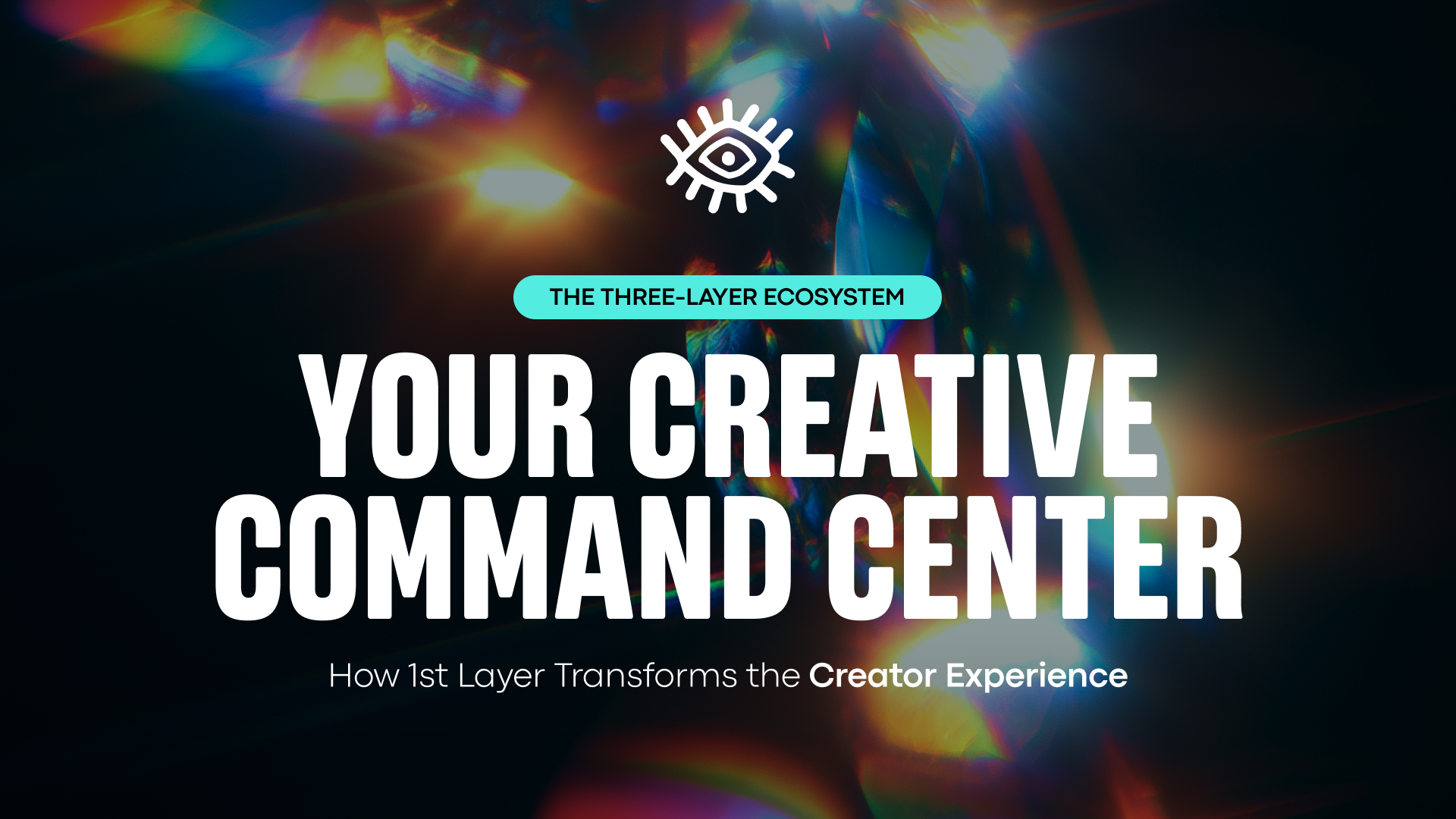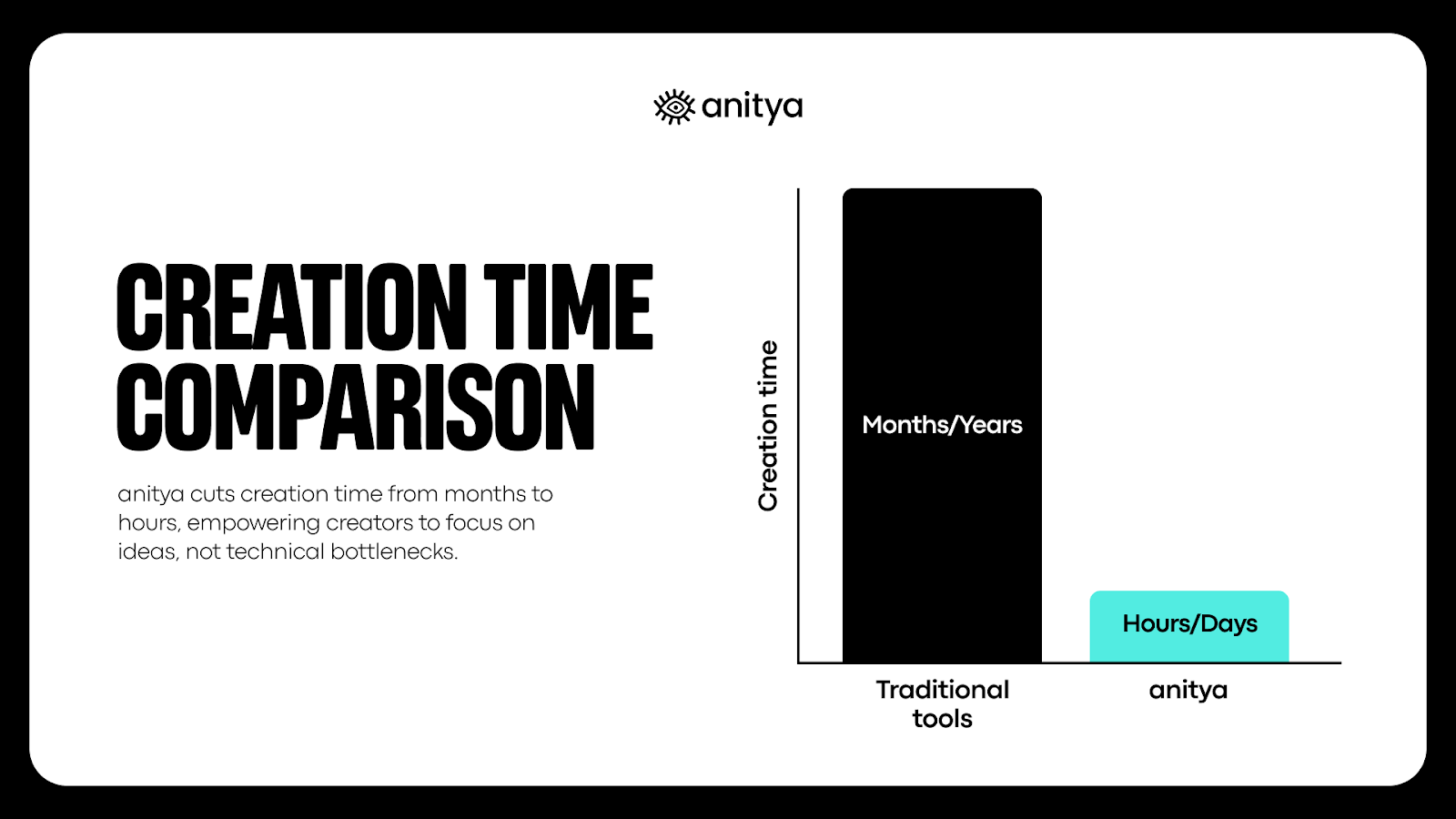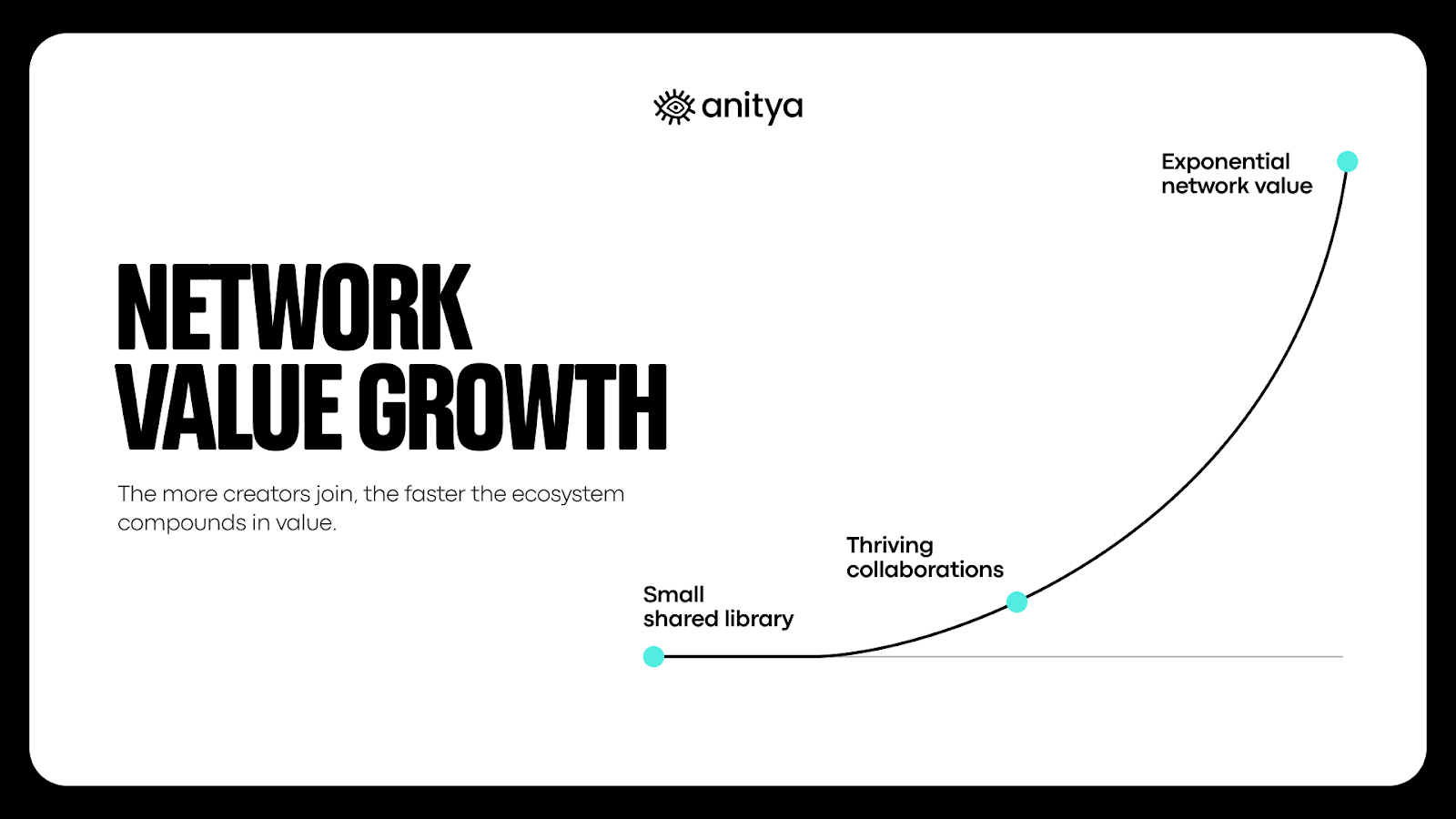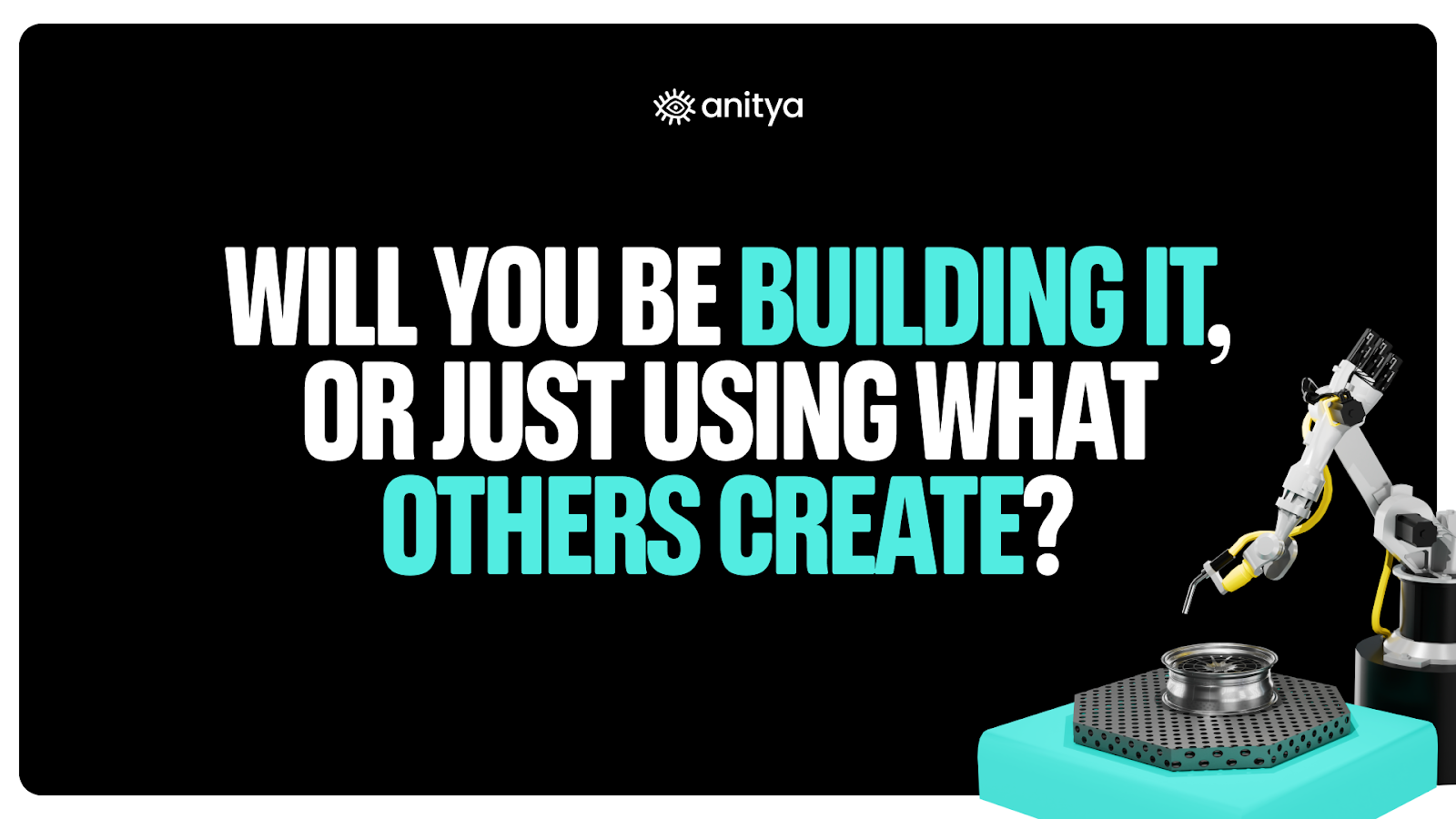How anitya Transforms the Future of Creation
This is the second article in our 4-part series exploring anitya's three-layer ecosystem. In our first article, we explored why 2025 is the year everything changes for creators. Today, we dive deep into Layer 1: the tools and experience that put creators in control of their creative destiny.

Remember when websites were built by programmers in basement offices, and the idea that your grandmother could create a blog seemed impossible? Then WordPress came along and suddenly millions of people were publishing online.
We're at that same moment with spatial content.
Right now, creating 3D experiences requires mastering 15+ specialized skills, costs $50K-$500K to get started, and takes 2-3 years to achieve basic competency. It's the exclusive domain of technical specialists working for big studios.
But what if creating immersive experiences was as easy as building a website? What if anyone could design virtual showrooms, interactive learning environments, or social spaces without writing a single line of code?
That's exactly what Layer 1 of the anitya ecosystem delivers: your creative command center for the spatial web.
The Spatial Web Is the Natural Next Step

To understand why this matters, think about how interfaces have evolved:
Text Era (1980s-1990s): Command lines and text-based interfaces. Only programmers could use computers effectively.
Visual Era (1990s-2010s): Graphical interfaces made computers accessible to everyone. Point, click, drag, drop.
Touch Era (2010s-2020s): Smartphones put computing power in everyone's pocket. Swipe, tap, pinch, zoom.
Spatial Era (2020s-2030s): AR glasses and VR headsets make digital content part of physical space. Look, gesture, speak, move.
Each transition democratized technology and created massive new opportunities for creators. The spatial transition is happening now, and it's the biggest shift yet.
By 2030, AR glasses will be as common as smartphones today. Digital content won't live on screens—it will exist in the world around us. The creators who understand spatial design, 3D interaction, and immersive storytelling will build the experiences that define this new era.
But here's the problem: current tools weren't designed for this future.
Why Current Tools Hold Creators Back
Traditional 3D development tools like Unity and Unreal Engine were built for game studios with teams of specialists. They assume you have:
- Technical expertise: Programming, scripting, shader development
- Specialized knowledge: 3D modeling, animation, lighting, physics
- Team resources: Artists, developers, designers, testers
- Time and budget: Months or years for development cycles
- Platform lock-in: Content tied to specific engines and ecosystems
For individual creators and small teams, these barriers are insurmountable. Even worse, these tools don't understand the collaborative, iterative nature of modern content creation. They were designed for the old model: big studios making big projects for specific platforms.
The spatial web requires a different approach:

Layer 1: Built for the Spatial Future
anitya's Layer 1 reimagines content creation for the spatial age. Instead of complex development environments, you get an intuitive creative command center that handles the technical complexity while you focus on creativity.
The Builder: No-Code Spatial Creation
The heart of Layer 1 is our drag-and-drop builder that makes 3D creation as easy as designing a presentation:
Visual Logic, Not Code. Connect components with visual nodes instead of writing scripts. Want a door that opens when someone approaches? Drag a proximity sensor to a door animation. Want music that changes based on the time of day? Connect a time trigger to an audio playlist.
Real-Time Collaboration. Multiple creators can work on the same experience simultaneously, from anywhere in the world. See changes instantly, leave comments, and iterate together in real-time.
Instant Publishing. Build once, publish everywhere. Your creation automatically works on web browsers, mobile devices, VR headsets, and AR glasses. No porting, no platform-specific development.
Open Technology Foundation. Built on Godot, an open-source engine that ensures your work isn't locked into proprietary systems. You own your creations and can export them in standard formats.

The Portfolio: Your Professional Creative Identity
But Layer 1 isn't just about creation tools. It's about building your professional identity as a spatial creator
Dynamic Showcase. Your portfolio isn't a static gallery—it's an interactive experience that demonstrates your skills. Visitors can walk through your virtual environments, interact with your designs, and experience your creativity firsthand.
Verified Project History. Every project you create is automatically documented with timestamps, collaboration details, and contribution tracking. Your portfolio becomes a verifiable record of your creative evolution
Cross-Platform Aggregation. Import work from other tools and platforms. Your portfolio becomes a comprehensive view of all your creative output, not just what you've built in anitya.
Reputation Building. As you create and collaborate, you build measurable reputation in specific skills: environmental design, interactive storytelling, user experience, technical innovation. Your reputation becomes a professional asset.
The Marketplace: Discovery and Monetization
Layer 1 also includes the infrastructure for creators to find audiences and generate revenue:
Curated Discovery. Experiences are ranked by engagement and community value, not just marketing budgets. Quality work gets discovered by people who appreciate it.
Direct Monetization. Token-gate premium content, charge for access to exclusive experiences, or offer subscription-based content libraries. Keep 85-95% of revenue instead of the 25% that traditional platforms leave you.
Remix Economy. Other creators can build on your work (with your permission), creating new revenue streams and expanding your creative influence. Every remix credits and compensates the original creator.
Community Building. Connect directly with your audience, gather feedback, and build lasting relationships without platform intermediaries.

Why Portfolio Ownership Changes Everything
The most important innovation in Layer 1 isn't any single feature—it's the concept of owned creative identity.
Traditional platforms own your audience, your content, and your reputation. If you leave, you start over. If they change policies, you adapt or disappear. If they shut down, your career vanishes.
With anitya, your portfolio is yours. Your audience relationships are direct. Your reputation is verifiable and portable. Your creative identity exists independently of any platform.
This changes the fundamental power dynamic between creators and platforms. Instead of being dependent on platform algorithms and policies, you own your creative destiny.
Proving Your Work Is Yours
In an age of AI-generated content and easy copying, proving authorship becomes critical. Layer 1 automatically creates a detailed record of your creative process:
Process Documentation. Every action you take while creating is timestamped and recorded. The system knows not just what you made, but how you made it.
Collaboration Tracking. When you work with others, everyone's contributions are clearly documented. No more disputes about who did what.
Version History. See how your work evolved over time, with complete records of iterations, feedback, and improvements.
AI Transparency. When you use AI tools, that's clearly documented too. Your portfolio shows which work is purely human, which is AI-assisted, and which is AI-generated.
This documentation becomes your creative DNA—a unique fingerprint that proves your authorship and builds your professional reputation.
The Network Effect of Spatial Creators
As more creators join Layer 1, the value increases for everyone:
Shared Asset Libraries. Creators contribute reusable components—3D models, animations, interactive elements—that others can build upon. The library grows richer with each new creator.
Collaborative Opportunities. Find other creators with complementary skills for joint projects. The platform facilitates introductions and collaboration.
Knowledge Sharing. Learn from other creators through shared techniques, tutorials, and best practices. The community becomes a learning accelerator.
Cross-Promotion. Creators promote each other's work, creating a supportive ecosystem rather than zero-sum competition.

Real Creator Success Stories
Layer 1 isn't theoretical—it's working for creators today:
Sarah, Educational Designer: Used to spend months creating VR training modules with traditional tools. Now builds interactive learning experiences in days and has tripled her client capacity.
Marcus, Brand Experience Creator: Went from charging $10K for static 3D renders to $50K for interactive brand experiences that clients can publish across all platforms.
The Collective Studio: A group of five creators who collaborate remotely to build virtual event spaces. They've gone from local freelancers to serving international clients.
Elena, Architectural Visualizer: Transformed her static architectural renderings into walkable experiences that help clients understand spaces before they're built. Her booking rate increased 400%.
These creators aren't just using better tools—they're building careers in the spatial economy while it's still emerging.
Getting Started Today
Layer 1 is live and ready for creators who want to build their spatial future:
Start Building: Visit anitya.space and create your first experience. The learning curve is gentle, and you'll have something interactive within hours.
Develop Your Portfolio: Import existing work and start building your verified creative identity. Every project you complete strengthens your professional reputation.
Join the Community: Connect with other spatial creators, share techniques, and collaborate on projects. The community grows stronger with each new member.
Monetize Your Skills: Start offering spatial content creation services. Demand is growing faster than supply, and early movers have significant advantages.
Prepare for Layer 2: As you build, you're automatically creating the attribution data that will power the economic opportunities in Layer 2.
What's Coming Next
Layer 1 is just the beginning. In our next article, we'll explore Layer 2: the attribution infrastructure that turns your creative work into verifiable assets and unlocks new economic models.
You'll discover how cross-platform tracking works, why attribution becomes your digital reputation, and how the economic infrastructure enables creators to build wealth from their creative contributions.
But you don't need to wait for Layer 2 to start building your spatial future. Every experience you create today becomes part of your verified creative DNA tomorrow.
The spatial web is being built right now. The question is:

Ready to start building?
- Try the anitya engine at anitya.space
- Join our creator community on Discord
- Follow this series for Layer 2 insights
- Share your first spatial creation with #anityacreator
Coming Next: "Your Attribution Infrastructure: How Layer 2 Creates Verifiable Creative DNA"
In our next article, we'll show you how every creative action becomes part of your permanent professional record, and why attribution infrastructure is the foundation of the creator economy's future.
